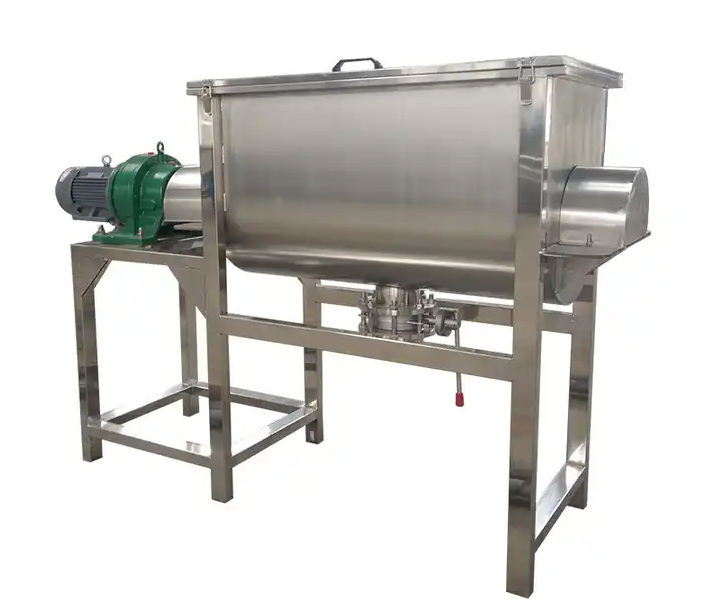
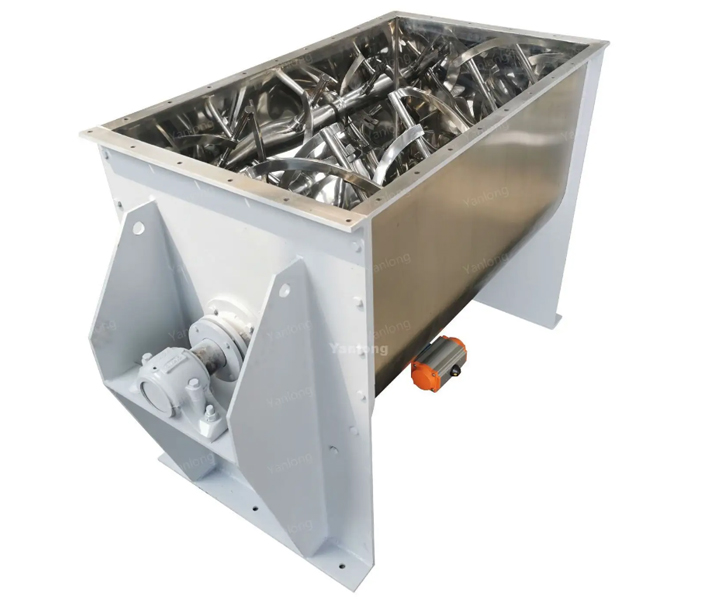
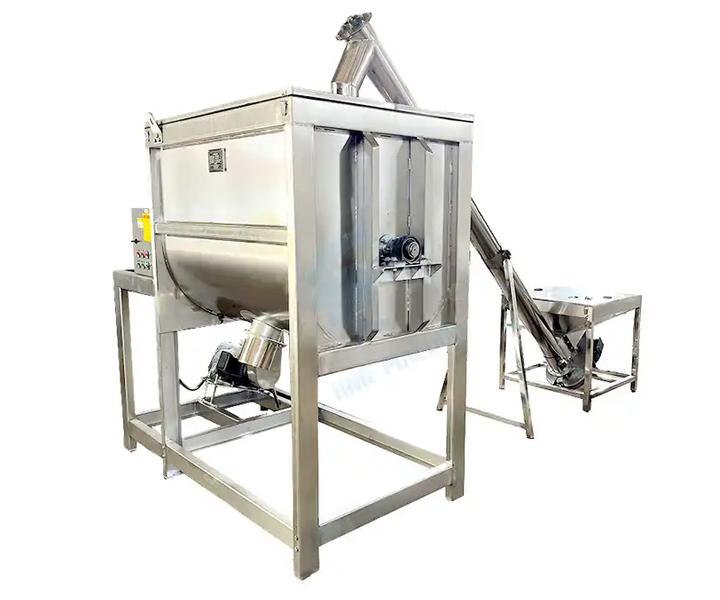
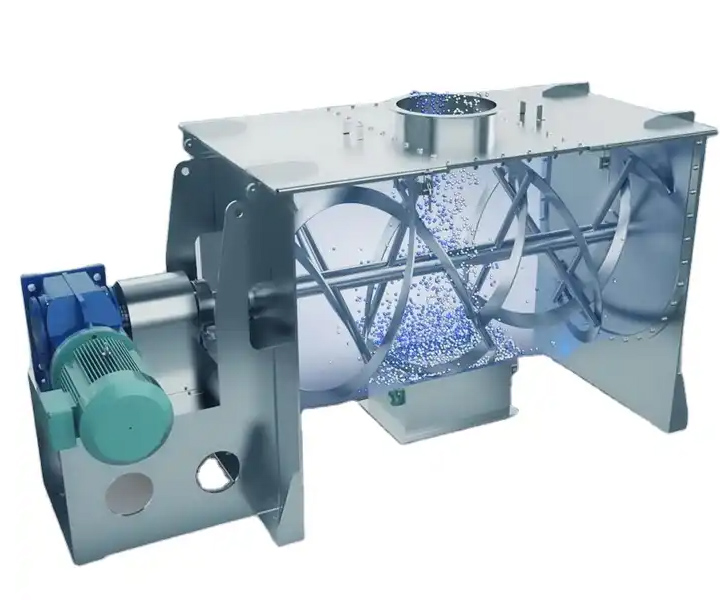
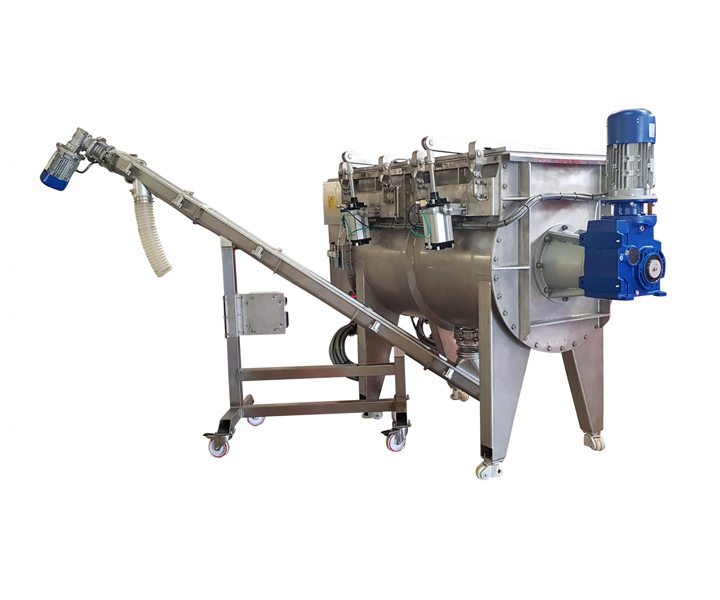





Consists of inner and outer helical ribbons that are designed to allow materials to be continuously and fully mixed. It is an industrial mixing equipment used to mix dry powders, granules and other solid materials.
![]()
![]()
Price::$1000.00-$7,900.00/Set
Consult now and enjoy a 10% discount
Mixing time: 8-20min
Frequency: 50HZ、60HZ
Mixing speed: 15-60r/min
Voltage: 380 Volt、Special customized 400v、 480v (Can be specially customized according to customer requirements)
One-time mixing: 100-6000 (kg) (If it exceeds 6000kg, it can be customized according to needs)
Application: Can handle a variety of materials including powders, granules, pastes and viscous materials. They are used in industries such as food processing, pharmaceuticals, chemicals, plastics and construction.
Ribbon mixer, also called horizontal ribbon mixer machine,ribbon blender,It consists of a cylindrical container with two parallel shafts in the center of the container. Attached to each shaft is a spiral ribbon blade, which rotates in opposite directions to move the material radially and laterally to achieve thorough mixing, suitable for mixing a variety of powdered, granular or viscous materials. Due to the convection mixing mode of the ribbon mixer, short and fast mixing cycles can be achieved, usually ranging from a few minutes to 20 minutes (depending on the volume and complexity of the recipe).
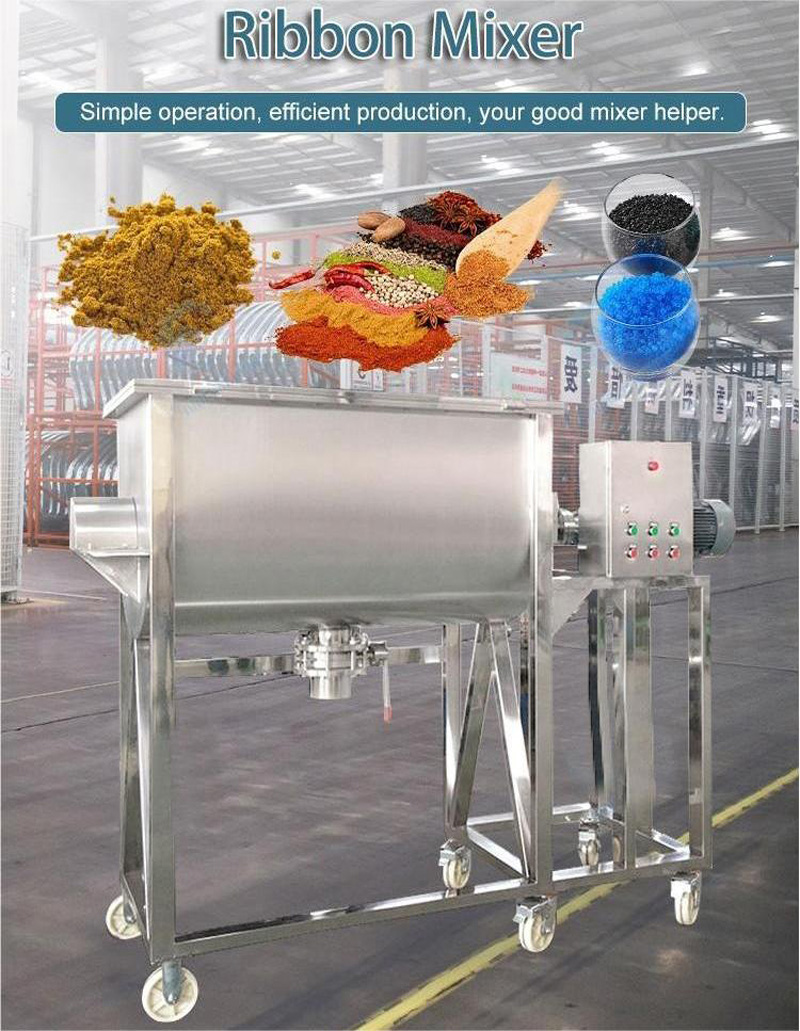
Ribbon mixers are available in a variety of sizes and configurations to accommodate different batch sizes and production requirements, with a variety of optional features to choose from, including custom ports on the lid, heating/cooling jackets, vacuum functions, interchangeable paddle agitators, high-speed choppers, sanitary surface treatments, all-stainless steel construction, liquid addition nozzles, pressure feed containers, pneumatic lids and valves, explosion-proof motors and controllers.
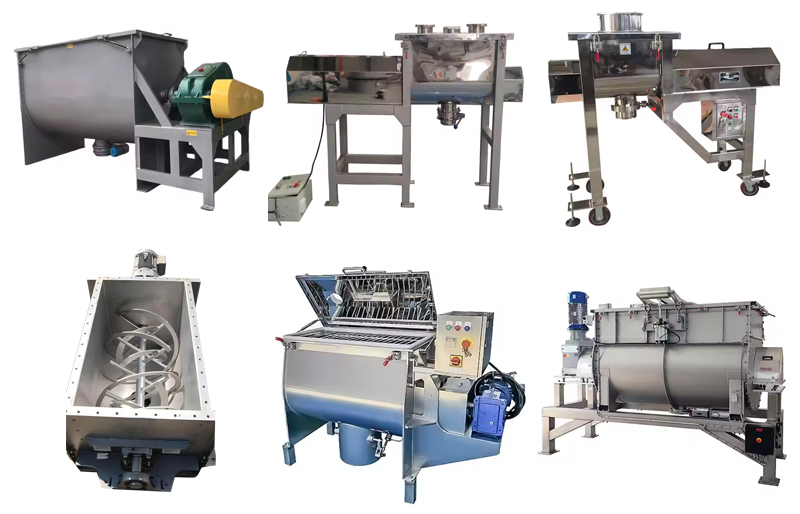
The ribbon mixer is a widely used equipment for mixing powder and granular materials. Its main functions include:
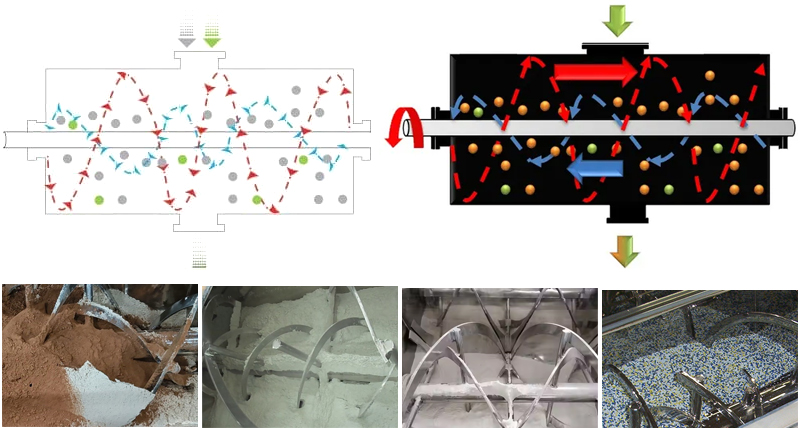
1. Uniform mixing: Through the rotation of the ribbon, different materials can be quickly and evenly mixed to ensure the consistency of the composition and properties of the mixed materials.
2. De-agglomeration: Effectively remove the agglomeration phenomenon in the material to ensure the fluidity and mixing effect of the material.
3. Volume expansion: Evenly disperse a small amount of high-value additives into a large amount of base material to improve the performance of the product.
The following are some common mixing methods of ribbon mixers:

1. Mixing powders with powders: It can effectively mix powders of different particle sizes or densities evenly, such as mixing flour and powdered sugar.
2. Mixing powders with liquids or pastes: It can evenly disperse liquids or pastes into powders to form a uniform mixture, such as mixing drug powders with adhesives in the pharmaceutical industry.
3. Mixing powders with solids: It can effectively mix powders and solid materials together to ensure the uniformity and consistency of the mixture, such as mixing plastic particles and additives.
We focus on the research and development, production and sales of ribbon mixers, and are committed to providing customers with efficient, stable and durable mixing solutions. With many years of industry experience, a strong technical team, advanced production equipment, and prices generally ranging from $1000.00 to $7,900.00/Set, it is suitable for various industries such as chemicals, food, medicine, feed, etc. With its efficient mixing effect, low energy consumption and easy maintenance, it has won the trust and praise of customers.
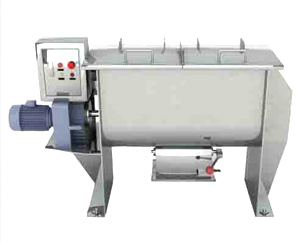
Horizontal Ribbon Mixer
The horizontal ribbon mixer is a type of mixing equipment that features a horizontal, cylindrical-shaped mixing chamber with a set of inner and outer helical ribbons.
Common applications: Widely used in the food industry for mixing dry ingredients such as spices, powders and condiments.
Common industries: Usually used in food processing, pharmaceuticals, chemicals, plastics and other industries.
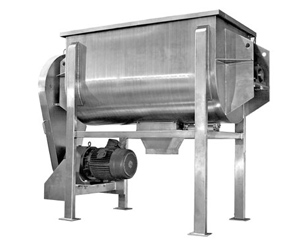
Stainless Steel Ribbon Mixer
A stainless steel ribbon mixer refers to a ribbon mixer that is constructed using stainless steel as the primary material for its mixing chamber and ribbons. Stainless steel is a popular choice for ribbon mixers due to its excellent properties, including corrosion resistance, durability, and ease of cleaning.
Common applications: Can handle a variety of materials including food ingredients, chemicals, powders and granules.
Common industries: food processing, pharmaceuticals, chemicals, cosmetics, etc. They are used to mix dry ingredients, blend powders, granules and viscous materials and produce homogeneous mixtures.
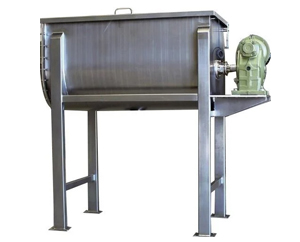
Ribbon Mixer 500 kg
Ribbon Mixer 500 kg is a 500 kg capacity ribbon mixer, which is suitable for handling larger batches of materials.
Common applications: It can mix powdered, granular or pelletized raw materials.
Common industries: It is commonly used in food processing, chemical, pharmaceutical, building materials and other industries.
Here's the principle and steps involved in the mixing process of a ribbon mixer:
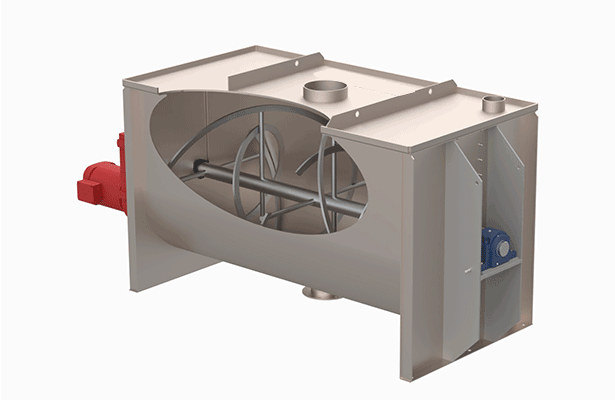
Loading: The materials to be mixed, such as powders, granules, or pastes, are loaded into the U-shaped trough of the mixer.
Rotation: The horizontal shaft, along with the inner and outer ribbon blades, starts rotating. The ribbon blades are designed to move the materials in a specific manner.
Shearing Action: As the ribbon blades rotate, they create a shearing action by moving the materials in opposite directions. The inner ribbon blade pushes the material in one direction, while the outer ribbon blade pushes it in the opposite direction. This shearing action helps break up clumps, agglomerates, or any cohesive particles present in the mixture.
Folding Action: The twisted design of the ribbon blades also causes a folding action as they move through the material. This folding action helps to further blend and homogenize the components, ensuring thorough mixing.
Circulation: The rotation of the ribbon blades also causes the materials to circulate within the mixing trough. This circulation helps to expose different parts of the mixture to the shearing and folding actions, promoting uniform mixing.
Discharge: Once the desired mixing time is achieved, the mixed material is discharged from the mixer through an outlet, typically located at the bottom of the trough.
| Ordinary ribbon form(internal mixing blade) | Internal mixing blade with scraper | Ribbon mixer with oil spraying device | Double ribbon agitator blade |
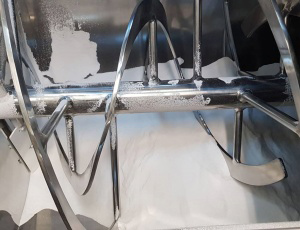 |
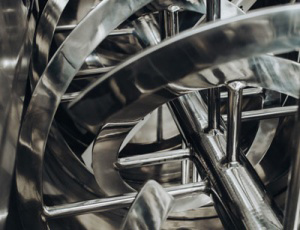 |
 |
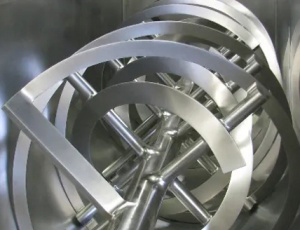 |
| The raw materials are mixed by forced convection through the rotation of the spiral blades. It has a simple structure and easy operation, and is suitable for general mixing tasks. | In addition to the spiral blades, it is also equipped with scrapers or internal stirring blades to increase the mixing effect. It is suitable for processes that require higher mixing uniformity, such as the mixing of special chemical raw materials. | Equipped with a spray gun device, liquid or powder raw materials can be added to achieve uniform spraying and mixing of raw materials. It is used in production processes that require the addition of liquid or powder raw materials during the mixing process. | Double ribbon agitators are designed with a continuous spiral, with no gaps between the ribbon flighting, it is best for low density, free-flowing materials that are of like size and shape. |
Efficient mixing
Designed to provide efficient, thorough material mixing. The rotating ribbon blades create a shearing and folding action that effectively mixes and homogenizes ingredients. This produces a homogeneous mixture with a consistent particle distribution throughout the mixture.
Versatility
Versatile and capable of handling a variety of materials including powders, granules, pastes and viscous materials. They are used in industries such as food processing, pharmaceuticals, chemicals, plastics and more. Ribbon mixers can accommodate different viscosities and densities, making them suitable for a variety of mixing applications.
Mix gently
Helps maintain the integrity and properties of sensitive materials. The low shear generated by the ribbon blades minimizes particle degradation, heat generation and product damage during mixing.
Fast mixing time
Designed for efficient mixing, allowing for relatively short mixing times. The combination of shearing, folding and circulating actions contributes to rapid mixing of materials, reducing overall processing time and increasing productivity.
Easy to clean and maintain
U-shaped channels and removable band blades allow for thorough cleaning between batches, minimizing the risk of cross-contamination. Additionally, the ribbon mixer’s simple design reduces the number of moving parts, making it easier to maintain and repair.
Scalability
Ribbon mixers are available in a variety of sizes, from small laboratory scale mixers to large industrial scale mixers. This scalability allows for flexibility in adapting to different batch sizes and production requirements.
Both ribbon mixers and paddle mixers are commonly used for mixing applications, but they have some differences in terms of their design and mixing capabilities. Here's a comparison between ribbon mixers and paddle mixers:
| Comparative Item | Ribbon Mixer | Paddle Mixer |
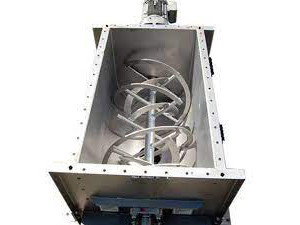 |
 |
|
| Equipment Design | Typically features a U-shaped groove, horizontal shaft, and twisted spiral blades. The ribbon-like leaves are arranged in a spiral pattern along the axis. | It has a cylindrical or rectangular mixing chamber with a rotating paddle or agitator mounted on the shaft. |
| Mixing Action | Utilizes the shearing and folding effects of rotating ribbon blades. Inner and outer ribbon blades move material in opposite directions, resulting in efficient mixing and homogenization. | Paddles or agitators that rotate on a shaft are used to produce a more vigorous mixing action, often involving a combination of fluidizing, lifting, and tumbling motions. |
| Mixing Efficiency | Provides uniform mixing and thorough particle distribution. They are particularly suitable for sticky materials and applications requiring gentle mixing. | Has a stronger mixing action and is generally better suited for applications that require more intense mixing, such as breaking up agglomerates or dispersing additives. |
| Material Handling | Can handle a variety of materials including powders, granules and pastes. They are particularly effective on sticky materials that tend to stick together or clump together. | Suitable for a variety of materials, but may be more effective on larger or heavier materials due to its powerful mixing action. |
| Mixing Times | Generally known for its relatively fast mixing time. The combination of shear, fold and loop actions facilitate rapid mixing. | The mixing action is stronger, so longer mixing times may be required, especially when working with materials that are difficult to disperse or break down. |
| Model | LHY-0.25 | LHY-0.5 | LHY-1 | LHY-1.5 | LHY-2 | LHY-3 | LHY-4 | LHY-6 | LHY-8 | LHY-10 |
| One-time mixing (kg) | 100-150 | 200-300 | 400-600 | 600-900 | 800-1000 | 1200-1800 | 1600-2400 | 2400-3600 | 3200-4800 | 4000-6000 |
| Mixing time (min) | 8-20 | 8-20 | 8-20 | 8-20 | 8-20 | 8-20 | 8-20 | 8-20 | 8-20 | 8-20 |
| Mixing speed (r/min) | 60 | 55 | 45 | 40 | 35 | 25 | 25 | 20 | 15 | 15 |
| Motor power (kw) | 3-5.5 | 4-11 | 7.5-15 | 11-18.5 | 15-22 | 18.5-30 | 22-37 | 37-55 | 37-55 | 45-75 |
| Weight (kg) | 500 | 900 | 1800 | 2500 | 3200 | 4100 | 5100 | 6300 | 7500 |
The structure of a ribbon mixer usually consists of the following major components:
Mixing Chamber: It is usually a horizontal U-shaped trough or cylinder that holds the material to be mixed.
Ribbon Agitators: Inside the mixing chamber, there are two or more spiral ribbon agitators. These agitators are usually mounted on a central shaft and rotate in opposite directions. The ribbon is in the shape of a spiral and is responsible for moving the material radially and laterally within the mixing chamber.
Shaft and Bearings: Provides the rotational motion required for the ribbon agitator to mix the material effectively.
Drive System: The motor and drive system are used to power the central shaft and rotate the ribbon agitator.
Discharge Valve: At the bottom of the mixing chamber, there is usually a discharge valve or outlet that allows the mixed material to be discharged after the mixing process is completed.
Lid or Hood: The mixing chamber is usually covered with a lid or hood that can be opened to load the material into the mixer and closed during the mixing process to prevent the material from spilling out.
Support Structure: The entire mixer is supported by a sturdy frame or legs to keep it stable during operation.
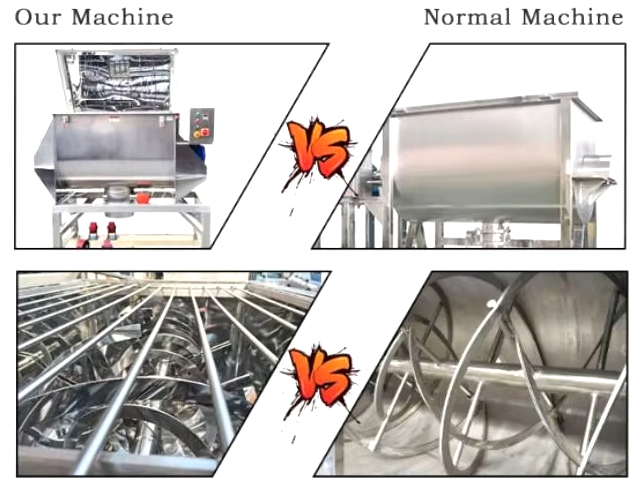
Agitators: The agitator is the most important component of the mixer, we offer several options: Double Ribbon Multi-Pitch、Double Ribbon Standard、Paddle、Trowel. All agitator types have at least one thing in common; the outer ribbon/paddle conveys material towards the discharge and the inner ribbon/paddle conveys material away from the discharge.

Material selection: The construction materials of the ribbon mixer can be selected according to the characteristics of the materials being processed. Common materials include stainless steel, carbon steel and special alloys. Stainless steel is a common choice because it has good corrosion resistance and is easy to clean.

Capacity and size: The ribbon mixer can be customized according to the required mixing capacity. Customers can choose from different capacity ranges to suit their production scale and batch size needs. In addition, the size and shape of the mixer can be customized to suit the factory's space constraints.

Mixing speed and time control: Generally, the mixing time of a ribbon mixer is between 5 and 20 minutes. The ribbon mixer can be equipped with a speed regulating device to adjust the mixing speed and time. This allows for flexible adjustments to different materials and mixing requirements to achieve the desired mixing effect.
Ribbon mixers have a wide range of applications in industrial production and are suitable for many different industries and fields. The following are common applications of ribbon mixers:
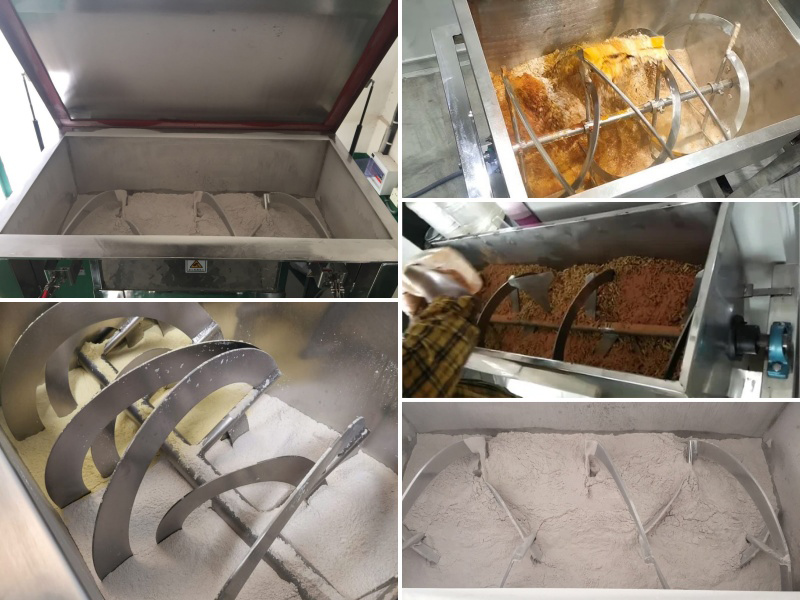
Food processing industry: used to mix various food raw materials, such as flour, powdered sugar, spices, grains, nuts, etc., to ensure product taste and quality.
Pharmaceutical industry: used to mix drug ingredients, powders, etc. to ensure the uniformity and stability of drug preparations.
Chemical industry: used to mix chemical products such as pigments, plastic particles, and coating raw materials to meet specific production needs.
Building materials industry: used to mix building materials such as cement, gypsum, and concrete additives to ensure the uniformity of the mixed materials.
Agricultural production: used to mix agricultural raw materials such as feed, fertilizer, and seeds to ensure the uniformity of feed and fertilizer.
Cosmetics manufacturing: used to mix cosmetic raw materials such as powders, pigments, and essential oils to produce various cosmetic products.

A chemical company needs to mix granular materials of different colors to produce colorful granular products. They chose a ribbon mixer for the solution. By adjusting the mixer's speed and mixing time, they successfully achieved uniform mixing of the granular materials and produced products with bright colors and stable quality. The efficient mixing and ease of operation of the ribbon mixer have greatly improved the company's production efficiency and product quality.
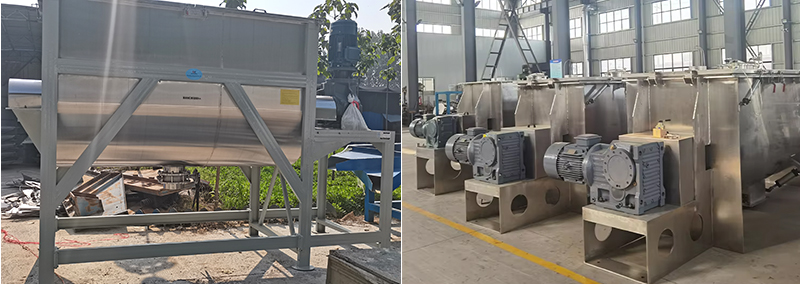
Xinxiang Dahan ribbon mixer manufacturer has the following advantages: First of all, it has rich experience and professional knowledge, has been committed to the research and development and manufacturing of ribbon mixers for many years, and has strong technical strength. Secondly, advanced production technology and high-quality materials are used to ensure product reliability and durability. In addition, Xinxiang Dahan ribbon mixer manufacturer focuses on innovation and continuously introduces advanced technology and equipment to improve product performance and efficiency. Finally, the company adheres to the principle of customer first and provides a full range of pre-sales and after-sales services to ensure customer satisfaction.
Address:China,Yanjin county forest park gate to the west 1000 meters north road.